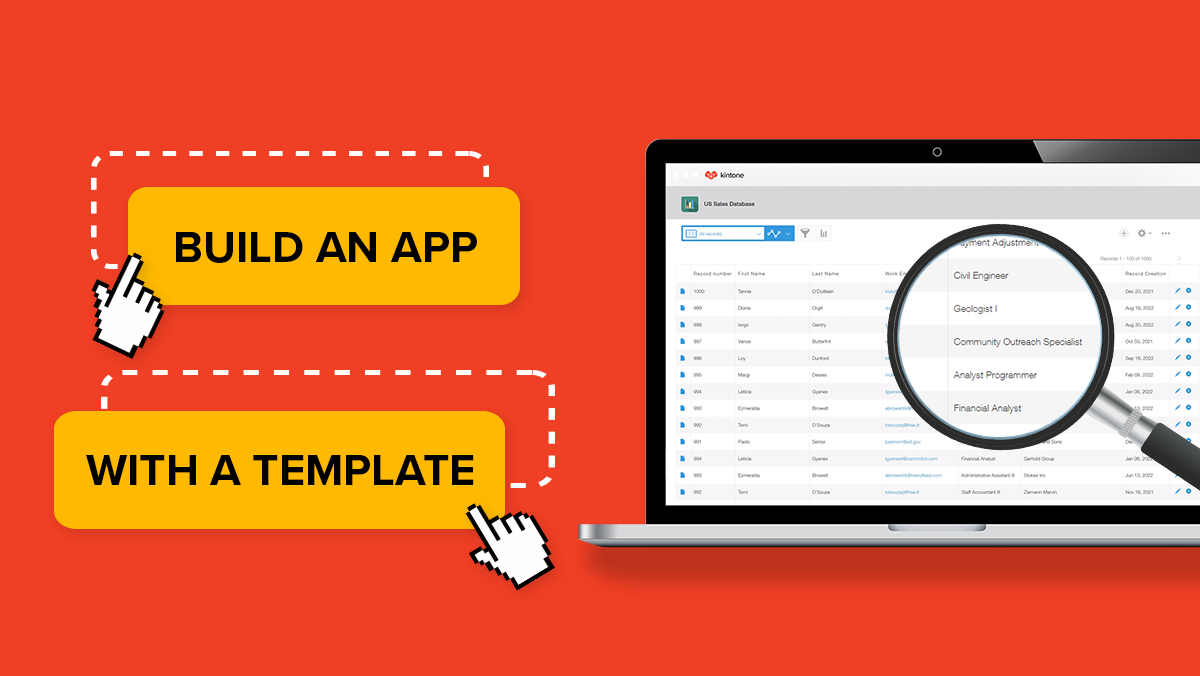Let’s say I ask you to build me a business software application.
Chances are, you’re going to give me a blank look. For most business people with no coding experience, software development is about as mystical as the innards of your phone—it’s a process that happens, but you don’t know how it works. It just does, and you trust that so long as you can use the end product that’s good enough.
But let’s say I ask you to build me a business software application. And instead of shooting me a blank look, you go, “Sure, what do you want it to do?”
The gap between the first reaction and the second isn’t filled with coding expertise: it’s filled by code-free visual programming platforms like Kintone and an understanding of what it takes to successfully build a business software application (which doesn’t require code but does require a little bit of old fashioned “engineer think”).
Let’s get the first part of that gap out of the way. What are visual programming platforms like Kintone?
Visual programming tools like Kintone are tools that empower citizen developers, or non-coders, to build custom enterprise software applications using a drag-and-drop interface. Unlike some other no code/low code platforms that require a bit of coding knowledge for setup or development, Kintone has a ton of functionality without any coding whatsoever. If you’ve never built anything like that before, however, you’re going to be tapping into a whole new set of skills.
Good so far? Onto the next part of that gap: developing that sense of “engineer think.”
For us non-engineers, we’re used to being the end user with an already laid out process and zero ambiguity about how things work in the app. So how do we switch our mindsets as we dive into building an app for the first time?
Fortunately for all of us, we have some software engineers around who not only have the engineer mindset but also the ability to share it with those of us who want to build applications but need a little help.
Nim and Steve, two very helpful members of the Kintone team, have put together a list of handy tips and guidelines to keep in mind as you start creating your very first applications. You’re not only learning how to think in a new way, but also learning how to use a brand new set of tools. This is a big deal!
1. Identify your requirements
In this initial stage, the goal is to identify a process you’d like to improve and figure out how to solve it with an application. Think about your end users (or talk it out with them). What information and features would be the most helpful for this user? List them out. If you’re the end user, you’re already one step ahead because you already understand the process and the features that would help improve it.
The reason this is more challenging than it sounds is that this might be a problem that is either unclear or may have more than one way to solve it. Another issue is that you’re not familiar with your toolkit yet. Learning the basics will help you understand which tool to use for which scenario. We’ll go into more detail about this in tip #2.
Read also: Kintone Help Center - How to Build an App
2. Learn the basics
Now that you have an understanding of what the data in your app will look like, it’s time to learn more about the building blocks. For Kintone, these basic building blocks are called fields. Depending on what data is going in your app, you need to pick the appropriate field for that data type.
For example, let’s say you’re building a Customer Database app. You can start by dragging and dropping a Text field into your app—this can be where you enter the customer’s first name. For data that might require automatic calculations, like monetary amounts for an Invoice app, use a Number field instead of a Text field. Each field type has its limitations, so learning about each one will help ensure that you pick the right type for what you need.
To help you get started, the Kintone Help Center has articles on a variety of topics and answers frequently asked questions. You can also watch a recorded demo or set up a quick one-on-one demo with a Kintone team member, who knows the ins and outs of the platform.
3. Ditch that perfectionist impulse
Traditionally, software development is done in “sprints,” which are set periods ranging from one week to one month depending on the team. To start, think about what can reasonably be accomplished in a two-week period. It will absolutely not be perfect...and that’s totally okay. For this first two-week sprint, think about what the minimum acceptable version of this app would look like and the ideal, fully built-out version. Your target is somewhere in between. If it helps, prioritize your list of requirements, starting with the most important features.
We’re all about the Kaizen Method at Kintone, which is all about incremental change and continuous improvement. The most important thing here is to learn as you go. Baby steps! In the software world, nothing is ever really done. You can keep iterating to make it better and better.
4. Lay out your app in a user-friendly way
Always keep your end user in mind as you’re laying out your app. Group data fields that logically go together and think about how apps can work together. For example, if your app is tracking financial information, have it all in one place so it’s easy to find. If the user will be referencing a particular customer in the Project Management Tracker app you’re building, you can store all the customer data in one app and use a Lookup field to pull data from that app.
One important question to ask when first building an app is if you’ll be using the mobile version of the app or just the desktop version. The interface for mobile is slightly different, and especially if the app requires data entry, you’ll want to think about whether the app views the same way. Mobile has a lot less screen real estate, so you’ll want to make sure it’s still easy to navigate.
You can save this for the second draft of your app, but think about ways to make your app more visually appealing and easier to navigate. You can color code apps, change icons, and add descriptions so that it’s easier to tell your apps apart. Is there a key feature missing? Maybe a label is misleading or unclear. You can easily change these things to keep improving your app.
5. Avoid common beginners’ mistakes
If you ever have duplicated data that needs to be manually entered in multiple apps, it’s a surefire sign that you can have those two apps connect. You never want to store redundant data in multiple places if it means there’s an opportunity for human error. For example, let’s say you have a customer named Bob Belcher. One user enters his name as Bob, but another might enter him as Robert. Little discrepancies like this can add up and lead to some seriously messy data. The solution? Use a Lookup or Related Record field to connect the apps. That way if someone updates his name to Robert in the datasource app, it’ll get updated across all of your connected apps.
Another common issue is picking the wrong field type for the data you’re trying to collect. Maybe you used a Multi-choice or Check Box field when you should have used a Radio Button. What’s the difference? Radio Button fields only let the user pick one option, while the other field types allow for multiple selections. Don’t like the look of Radio Buttons? You can also use a Drop-down field and set it up so that users can only pick one option. Make sure the user’s options are clear and concise. Too many choices means your data won’t be as useful.
The last common mistake according to our Kintone experts is not having a unique identifier for each record or line item in the app. Going back to our Customer Database example, let’s say you have two customers named Bob. What’s the best way to keep them separate and tell them apart? What about a customer ID number? This would be unique to every record (ie. customer) in the app, and you can use a Record Number field if you want this to be assigned automatically.
If you still have questions or you’re unsure that Kintone can solve one of your workflow challenges, schedule some time to talk to one of our team members. If the capability doesn’t already exist in Kintone or through an existing extension or plugin, nine times out of ten there is a workaround. We’re here to help!
If you’re ready to dive in and become a visual programmer, sign up today for a free trial of Kintone, no credit card required. You can start building your own enterprise apps for desktop and mobile using one of our templates or start from scratch with Kintone’s drag-and-drop interface.
About the Author
Euna is a Senior Content Specialist at Kintone. She holds a BA in English from the University of Michigan and has a thing for words, food, and travel.










